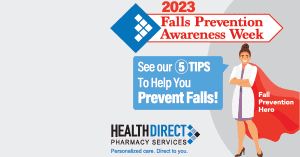As healthcare leaders and providers, reducing hospital readmissions is a commitment you make to benefit your residents and the viability of your facility. Yet developing effective readmission reduction strategies can feel like a difficult, even insurmountable challenge. Developing a new program or updating an existing program can prove especially difficult as you and your staff balance your immense day-to-day responsibilities.
The potential harm of repeated hospitalizations stack up quickly for LTC residents. Consider the physical, emotional and financial toll of prolonged illness and time away from family, as well as increased infection risk and virus exposure. A 2017 National Quality Forum report shares that the cost of all-cause adult hospital readmissions tops $40 billion a year, and estimates that 5 to 79 percent of hospital readmissions may be preventable. The same report suggests that reducing preventable admissions by merely 10 percent could save the healthcare system more than a billion dollars.
Delivery at discharge: Readmission prevention strategies
We know you are deeply committed to your residents’ wellbeing, and HealthDirect is here to help. Factors contributing to preventable hospital readmissions are complex, varied and may include environmental, community and resident-level factors. Multifactorial causes support the idea that coordinated care across providers, including hospitals, skilled nursing facilities, clinicians and pharmacy may go a long way toward preventing readmissions.
Avoid Costly Fines with Coordinated Care
By working with HealthDirect, a skilled nursing facility (SNF) can adopt pharmacy-driven strategies to reduce hospital readmissions. The truth is, adverse drug events (ADEs) lead to nearly 100,000 hospitalizations per year, and fatal ADEs are estimated to rank among the top six leading causes of death in the U.S. Moreover, ADE-driven rehospitalizations are estimated at 17 percent, indicating a need to target medication management in many patients.[1] The takeaway: medication review and reconciliation are extremely important; pharmacists’ expertise will be integral to any organizations successful program to reduce hospital readmissions.
Our customized approach, Delivery at Discharge, is a transition of care program designed specifically to reduce preventable hospital readmissions from high risk discharges; helps you avoid costly penalties and fines and improve patient outcomes. The program helps synchronize care coordination across patient settings, from the hospital, SNF facility or rehabilitation center to the patient’s home or assisted living care community.
The program is collaborative, rather than competitive, and is implemented with discharge planning from the hospital or admission department with a SNF or rehabilitation center. The program is operating in large, medium and small hospitals and partnering with new skilled-nursing and rehabilitation facilities every month.
Readmission Prevention Strategies for Diseases
The Delivery at Discharge program offered through HealthDirect helps Skilled-Nursing Facilities prevent readmission to hospital following discharge and avoid fines by supporting post-discharge medication compliance. This unique and innovative program applies to high risk discharges and focuses on CMS identified conditions. (OIG report, Nov 2013). [2]
– COPD
– Pneumonia
– Congestive Heart Failure
– Myocardial Infarction
– Joint Replacement
With our custom-developed Delivery at Discharge checklist, your staff will be able to proactively identify risk factors for patients who have a high chance of readmission, so that you can address them to reduce the probability of rehospitalization. The bottom line: you will play an essential role in quality improvement across the healthcare system and improve patient care and outcomes. Checklist questions are customized and developed in alignment with the most common causes for readmission related to each of these five disease states.
Post-Discharge Medication Compliance
An estimated 40 percent of preventable admissions are attributed to medication-related issues, and the stakes, from quality rankings, to Accountable Care Organization (ACO) eligibility, to fines, are high.
Delivery at Discharge offers a comprehensive platform to provide facilities with transition of care services. In addition, it streamlines medication reconciliation and patient education at the point of discharge. On top of that, it provides for free prescription delivery and face-to-face pharmacist consultation with the patient, their family and their caregivers.
It all starts with the admission process. Delivery at Discharge allows for case management to target high risk, high maintenance patients. From there:
- Patients opt in to the program.
- Pharmacy provides prescriptions and counseling services to the patient at their bedside, prior to discharge.
- Drug Utilization Reviews are performed, including all prescription
sand over-the-counter medications. - Transition of care follow-up calls are made to participating patients over the following 30 days, to ensure medication adherence and to identify disease-state management concerns.
Free prescription delivery services supports access to medications after the patient is discharged. Compliance to any medication regimen starts with access to medication.
To ensure enrolled patients stay on track with their therapy, they receive three follow up phone calls from our trained pharmacists within 30 days of their discharge. The pharmacist provides full drug utilization review and reconciliation, screens the patient for any side effects and the potential for noncompliance and makes a disease state progression assessment to identify concerns. Concerns are then documented electronically and relayed to the attending physician and/or primary care physician.
Delivery at Discharge: A Solution for Multiple Disease States
Whether your facility is a large operation eager to stay on top of rapidly-changing regulations and standards, or a smaller skilled-nursing facility or rehabilitation center with limited staff, having a knowledgeable partner on your side to help you navigate regulations and lower readmission rates is key. At HealthDirect, we can help you with everything from education to training. And when it’s time to amass an interdisciplinary team to minimize re-admissions, we’re here to help you determine strategy.
For more information, call your local HealthDirect pharmacy. You can also contact us through our website or send us an e-mail.
[1] 1. Budnitz DS, Lovegrove MC, Shehab N et al. Emergency hospitalizations for adverse drug events in older Americans. N Engl J Med 2011;365:2002-12. 2. Advinha AM, de Oliveria-Martins S, Mateus V et al. Medication regimen complexity in institutionalized elderly people in an aging society. Int J Clin Pharm 2014;36:750-6. 3. Willson MN, Greer CL, Weeks DL. Medication regimen complexity and hospital readmission for an adverse drug event. Ann Pharmacother 2014;48:26-32.
[2] HHS / OIG. Medicare nursing home hospitalization rates merit additional monitoring. Nov 2013




